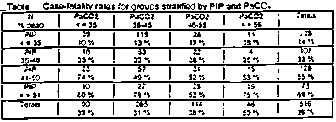
| 11 th Annual Pediatric Critical Care Colloquium |
| Session/Time | Pulmonary II/Thu, 2:00 - 4: 00 PM |
| Title | Permissive Hypereapnia Decreases Mortality From Acute Hypoxemic Respiratory Failure |
| Author | K Sichting, MD; P Havens, MD, MS |
| Affiliation | The Pediatric Critical Care Study Group (PCCSG) Medical College of Wisconsin/Children's Hospital of Wisconsin |
| Introduction | Permissive hypercapnia is advocated for treatment of patients with acute hypoxemic respiratory failure (AHRF),but limited clinical data exists on the its use in children. nis retrospective multi-center cohort study was performed to determine if permissive hypercapnia is associated with decreased mortality in pediatric patients with AHRF. |
| Method | The data for this study Were originally collected in 1992 for the protocol "Risk of Mortality in Pediatric Acute Respiratory Failure" of the PCCSG (Chest 1995; 103:789-97). Data were available for 679 patients who were mechanically ventilated with PEEP > 6 cm and FiO2 > 0.50 for 12 hours who were in the initial study. Patients not eligible for permissive hype rcapnia, i.e. those with a risk of increased intracranial pressure, were excluded from this study. We calculated the median PIP and PaCO2 values for the duration of mechanical ventilation, and calculated the case-fatality rates for 4 groups of PIP and PaCO2 (table). Logistic regression was used to examine the association between death, PIP and PaCO2 while controlling for confounders such as PEEP, PRISM score, shock, post- operative status, age and oxygenation index. A lung protective strategy and a non-lung protective strategy were defined and patient outcomes utilizina both strategies were compared.516 patients were included in this study. |
| Result | 516 patients were included
in this study. The overall mortality for the group was 36.0 %. Examination of the case-
fatality rates demonstrated that within each PaCO2 group increasin- PIP was associated
with increased mortality. Within each PIP group, increasing PaCO2 had no impact on
mortality(table). Logistic regressoin was used to control for severity of illness and
other confounders and demonstrated a rising PIP was associated with increased risk of
death. Compared to patients with a median PIP
< 35 cm H2O, those patients with medianPIP 36-40 cm H20 had a 2.7 ((%%CL= 1.8, 3.6)
greater odds of death and those with a median PIP 41-50 cm H2O had a 4.9( 95 % CL=3.9, 6.
1) greater odds of death. The use of a lunc., protective strategy was associated with
decreased mortality even after stratifying patients by severity of lung injury using
oxygenation index.
|
| Conclusion | Permissive hypercapnia is beneficial when utilized as a therapeutic modality in pediatric patients |
Use your browser's back button to return to the appropriate index of abstracts...
Back to PCCC 98 Abstract Introduction | Back to PCCC 1998